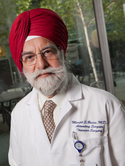A phase II trial of preoperative combined-modality therapy for localized esophageal carcinoma: Initial results Journal Article
| Authors: | Bains, M. S.; Stojadinovic, A.; Minsky, B.; Rusch, V.; Turnbull, A.; Korst, R.; Ginsberg, R.; Kelsen, D. P.; Ilson, D. H. |
| Article Title: | A phase II trial of preoperative combined-modality therapy for localized esophageal carcinoma: Initial results |
| Abstract: | Objective: We sought to evaluate treatment response to a novel combined-modality treatment regimen for localized esophageal carcinoma. Methods: Localized esophageal carcinoma was confirmed with endoscopic ultrasonography, computed tomography, and positron emission tomography before induction therapy. This therapy consisted of combined cisplatin/paclitaxel (cisplatin, 75 mg/m2; paclitaxel, 175 mg/m2; 2 cycles, 3-hour infusion) for weeks 1 and 4, combined cisplatin (30 mg · m-2 · wk-1) and paclitaxel (30-80 mg · m2 · wk-1, 96-hour infusion) with concurrent radiation (external beam, 1.8 Gy/d; total, 50.4 Gy) for weeks 7 to 12, and esophagectomy for week 16 after restaging confirmed resectability. Results: Forty-one patients (36 men) with adenocarcinoma (n = 25) or squamous cell carcinoma (n = 16) were enrolled. Thirty-six patients completed treatment, of whom 34 (85%) had locally advanced disease of clinical stage T3-4 N0-1. Symptoms resolved or improved in 35 (92%) of 38 patients after induction chemotherapy. Fourteen (35%) and 10 (24%) patients experienced grade III/IV myelosuppression during induction chemotherapy and chemoradiation, respectively. Two (5%) had grade III and none had grade IV esophagitis during chemoradiation. Only 2 (5%) patients required enteral feeding-tube support during therapy. Of 33 R0 resections, 9 (26%) had complete pathologic disease, and 4 (12%) had microscopic residual disease. Major (eg, anastomotic response, delayed stricture, and respiratory failure) postoperative morbidity occurred in 13 (36%) of 36 patients. Operative mortality was 5.5% (2/36). Conclusion: This regimen of induction concurrent chemoradiation followed by surgical intervention for esophageal carcinoma produces rapid dysphagia relief with initial chemotherapy, has a high overall response rate, and has acceptable toxicity levels. |
| Keywords: | adult; cancer chemotherapy; clinical article; treatment outcome; aged; middle aged; clinical trial; fatigue; carcinoma, squamous cell; cisplatin; multimodality cancer therapy; paclitaxel; cancer radiotherapy; preoperative care; combined modality therapy; cancer staging; neurotoxicity; cancer palliative therapy; adenocarcinoma; nephrotoxicity; phase 2 clinical trial; bone marrow suppression; blood toxicity; esophagitis; mucosa inflammation; antineoplastic combined chemotherapy protocols; diagnostic imaging; postoperative complication; dysphagia; gastrointestinal toxicity; esophagus resection; surgical mortality; phase 1 clinical trial; esophagus carcinoma; esophageal neoplasms; ototoxicity; humans; human; male; female; priority journal; article |
| Journal Title: | Journal of Thoracic and Cardiovascular Surgery |
| Volume: | 124 |
| Issue: | 2 |
| ISSN: | 0022-5223 |
| Publisher: | Mosby Elsevier |
| Date Published: | 2002-08-01 |
| Start Page: | 270 |
| End Page: | 277 |
| Language: | English |
| DOI: | 10.1067/mtc.2002.122545 |
| PUBMED: | 12167786 |
| PROVIDER: | scopus |
| DOI/URL: | |
| Notes: | Export Date: 14 November 2014 -- Source: Scopus |
Altmetric
Citation Impact
BMJ Impact Analytics
Related MSK Work








